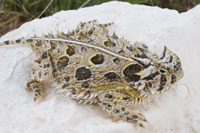Supplement to the July 2008 REPTILES magazine article "Feed Me!"
 Texas horned lizards (Phrynosoma cornutum) are specialty feeders. They must be given ants to do well in captivity. They will also eat some crickets. Photo by Gerold Merker |
Having trouble getting that hognose snake to eat? Have a lizard not interested in anything you provide? Researching an animal’s needs and finding a way to meet them is the first step to providing for your pet. Below are a few examples of reptiles with specialized diets. In order to keep these herps successfully, you must meet their captive care requirements.
1. North American horned lizards (Phrynosoma spp.) use their small oral cavity and highly dexterous tongue to eat ants in the wild. Currently it is believed that at least a portion of their captive diet should consist of harvester ants (Pogonomyrmex spp.).
2. Eastern hognose snakes (Heterodon platirhinos) are known to feed predominantly on various anuran species in the wild. Some herpkeepers purchase inexpensive anurans to offer snakes that refuse cultured rodents. The western hognose snake (Heterodon nasicus) can usually be enticed to feed by offering rodents scented with their preferred anuran species.
3. Mountain kingsnakes (Lampropeltis zonata and L. pyromelana) and gray-banded kingsnakes (Lampropeltis alterna) are notoriously poor feeders on pinky mice, especially as neonates. Working with these species for 30 years, we are often frustrated by their lack of feeding response when offered cultured food items. Even captive-bred snakes have this problem. For the past 15 years we have had good success in getting these animals to feed using the following strategies. Besides using cages kept at 85 degrees Fahrenheit with hide areas, we offer baby snakes fresh pinky mice, washed pinky mice, frozen mice, thawed pinky mice, washed pinky mice scented with lizard, and finally a washed pinky mouse with a small square of lizard skin. We always try an undoctored pinky mouse first, and then use the other options in no particular order to entice the snake into eating. We also pull off a small piece of lizard tail and place some of the blood from the lizard on a clean pinky mouse. Usually, the baby snake accepts one of these items. If not, we offer the animal an appropriately sized lizard followed immediately by a pinky mouse. Usually this last option does the trick, and the baby snake feeds. Persistence is the key. We rarely have baby snakes reject food for prolonged periods when using this protocol.
Keep in mind that when you make the commitment to care for an animal, you must provide it with what it needs to thrive. This includes an optimal living environment and nutritious food choices. The more effort you put into this, the more rewarding an experience you will have, and the healthier your animal will be.
Want to read the full story? Pick up the July 2008 issue of REPTILES today, or subscribe to get 12 months of articles just like this.



